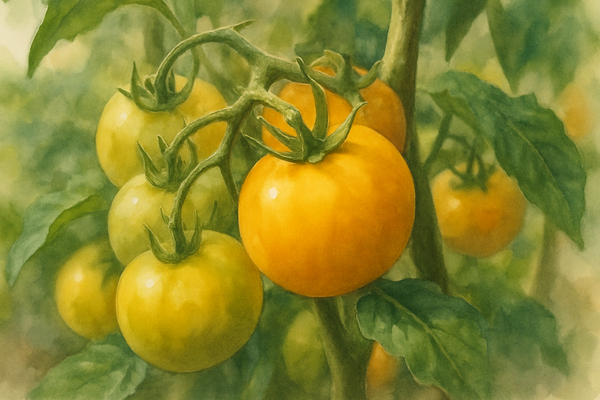There’s something undeniably joyful about the sight of a yellow tomato ripening in a Cornish garden. Where red might shout with bold flavour, the soft golden glow of Solanum lycopersicum ‘Golden Sunrise’ feels like a promise of something gentler—fragrant, sweet, and sun-warmed. Whether trained along the old stone wall of a kitchen garden, nestled in pots on a balcony, or strung up in the shelter of a glasshouse, this heritage favourite brings both beauty and abundance. And the best part? It all begins with a seed.
A Gentle Start: Sowing ‘Golden Sunrise’
Begin indoors between January and April if you’re planning a greenhouse crop; March to early May works well for outdoor tomatoes. The key is warmth and patience. Use fine, seed-start compost and shallow trays or cell modules—avoid heavy garden soil, which can harbour pests or drain poorly.
Sow the tiny seeds just 2mm–0.5cm deep. A whisper of compost or a sprinkle of vermiculite over the top is all they need. Pre-moisten the compost before sowing, then gently firm and keep consistently damp but never wet. Place trays somewhere warm: a sunny windowsill, a propagator set to 18–20°C, or a cozy spot above a radiator.
In around 6 to 14 days, the first green hooks will unfurl.
Nurturing the Seedlings: Light, Warmth, and Watchfulness
As soon as your seedlings show their heads, they’ll need light—lots of it. A bright, south-facing window or LED grow lights will stop them getting leggy. Rotate the trays daily so each side reaches equally, encouraging straight, sturdy stems.
Let the top of the compost dry slightly between gentle waterings, and if you can, water from below to draw roots downward. Once the first true leaves appear, prick out the strongest seedlings into individual 7cm pots, handling them by the leaves, never the delicate stem.
As they grow, pot them on again into larger containers when their roots begin to fill the space. Use a rich, free-draining compost and continue to water lightly but regularly. Once the seedlings are big enough to handle and the days are milder, it’s time to prepare for life outdoors.
Out into the Light: Hardening Off and Planting Out
In Cornwall, transplanting typically happens around late May or early June—after the last whispers of frost have gone and the nights hold a steady 12°C or more. But before you do, your tomatoes need to toughen up.
Harden off your young plants gradually over 7–10 days, beginning with an hour or two outside in a sheltered, semi-shaded spot. Each day, increase their time in the elements, avoiding cold winds and scorching midday sun.
When ready, plant them in a spot that basks in at least 8 hours of full sun daily. Choose well-drained, fertile soil, enriched with compost or well-rotted manure. If growing in pots, select large containers with good drainage and plenty of organic matter mixed in.
Bury the plants deeply—right up to their lowest set of leaves. This encourages root formation along the buried stem, building a strong anchor for the season ahead. Immediately stake or cane the plants to support their growth, and tie in as needed with soft string.
The Summer Routine: Water, Feed, and Train
Tomatoes thrive on rhythm. Keep the soil evenly moist, watering deeply and early in the morning. Avoid splashy watering or letting the soil dry out and then flooding it—this erratic pattern leads to fruit splitting or blossom end rot.
Once the first truss of fruit sets, switch to a high-potash liquid feed (tomato feed) every 10–14 days. If you’re growing in containers, weekly feeding may be needed.
Train the plant as a cordon, pinching out side shoots between leaf and stem once they’re 5–7cm long. This focuses the plant’s energy into fruit, not foliage. As the season progresses, remove some lower leaves to improve airflow and reduce disease risk.
Sunlight is essential. Ensure your plants receive 10–12 hours of direct light if possible. If you’re growing against a wall or in a pot, turn them regularly to avoid shaded clusters that ripen unevenly.
The Fruits of Your Labour: Harvest and Enjoyment
The golden fruits will begin to blush with warmth around midsummer. Harvest when they glow rich yellow and yield slightly to gentle pressure. Use scissors or a knife to avoid damaging the plant, and pick regularly to encourage more.
These tomatoes are as beautiful on the plate as they are on the vine. Slice them fresh into summer salads, pile them into bruschetta with garden basil, or roast them whole with a drizzle of oil and sea salt.
Notes on Care: Pests, Weather, and Cleanliness
Even the sunniest Cornish garden has its challenges. Protect your crop by watering at the base to keep foliage dry, mulching around the roots to stabilise moisture, and spacing plants to allow air to move freely.
Aphids and whitefly can appear in warm spells—encourage ladybirds, or use an organic soap spray if needed. Watch too for spider mites in greenhouses and slugs at ground level.
Consistent care and clean habits—removing faded leaves, cleaning tools, and checking plants daily—will keep most troubles at bay.
In Closing
Tomato ‘Golden Sunrise’ rewards those who tend it with sweetness, colour, and a taste of high summer in every bite. With just a little care from seed to fruit, this variety offers not only a delicious harvest but a daily reminder of why we grow. In Cornwall, where light and shelter are treasures, it brings a touch of golden magic to even the smallest garden plot.











